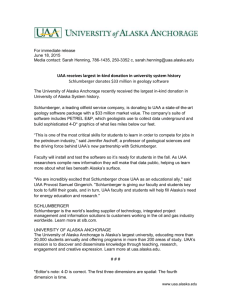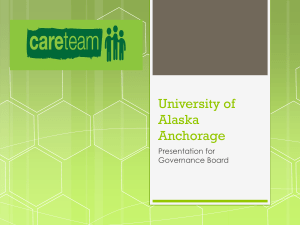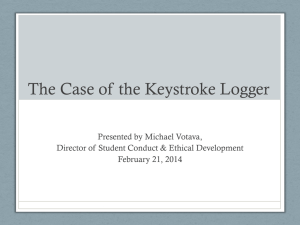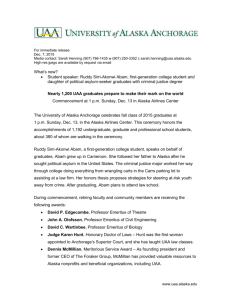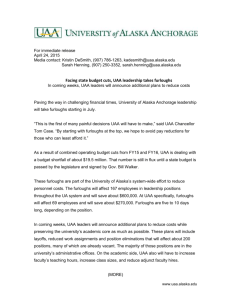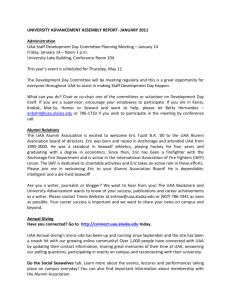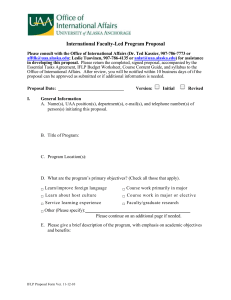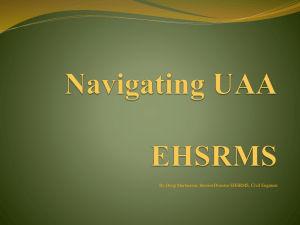Guidance for Academic Decisions in a Climate of Declining Budgets
advertisement
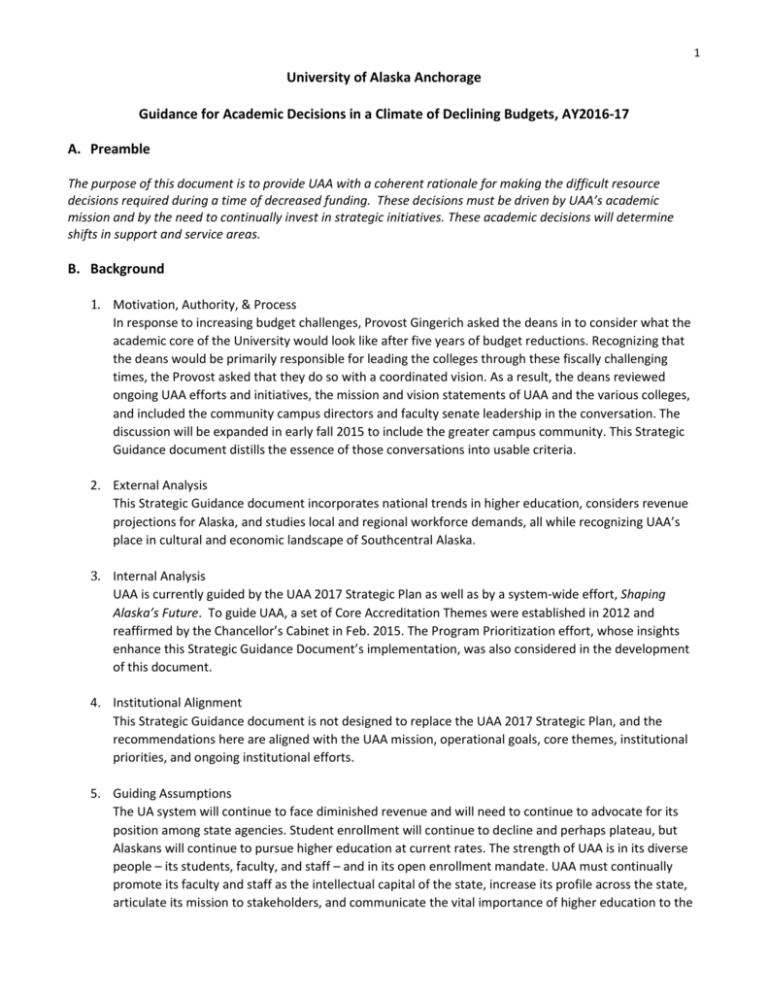
1 University of Alaska Anchorage Guidance for Academic Decisions in a Climate of Declining Budgets, AY2016-17 A. Preamble The purpose of this document is to provide UAA with a coherent rationale for making the difficult resource decisions required during a time of decreased funding. These decisions must be driven by UAA’s academic mission and by the need to continually invest in strategic initiatives. These academic decisions will determine shifts in support and service areas. B. Background 1. Motivation, Authority, & Process In response to increasing budget challenges, Provost Gingerich asked the deans in to consider what the academic core of the University would look like after five years of budget reductions. Recognizing that the deans would be primarily responsible for leading the colleges through these fiscally challenging times, the Provost asked that they do so with a coordinated vision. As a result, the deans reviewed ongoing UAA efforts and initiatives, the mission and vision statements of UAA and the various colleges, and included the community campus directors and faculty senate leadership in the conversation. The discussion will be expanded in early fall 2015 to include the greater campus community. This Strategic Guidance document distills the essence of those conversations into usable criteria. 2. External Analysis This Strategic Guidance document incorporates national trends in higher education, considers revenue projections for Alaska, and studies local and regional workforce demands, all while recognizing UAA’s place in cultural and economic landscape of Southcentral Alaska. 3. Internal Analysis UAA is currently guided by the UAA 2017 Strategic Plan as well as by a system-wide effort, Shaping Alaska’s Future. To guide UAA, a set of Core Accreditation Themes were established in 2012 and reaffirmed by the Chancellor’s Cabinet in Feb. 2015. The Program Prioritization effort, whose insights enhance this Strategic Guidance Document’s implementation, was also considered in the development of this document. 4. Institutional Alignment This Strategic Guidance document is not designed to replace the UAA 2017 Strategic Plan, and the recommendations here are aligned with the UAA mission, operational goals, core themes, institutional priorities, and ongoing institutional efforts. 5. Guiding Assumptions The UA system will continue to face diminished revenue and will need to continue to advocate for its position among state agencies. Student enrollment will continue to decline and perhaps plateau, but Alaskans will continue to pursue higher education at current rates. The strength of UAA is in its diverse people – its students, faculty, and staff – and in its open enrollment mandate. UAA must continually promote its faculty and staff as the intellectual capital of the state, increase its profile across the state, articulate its mission to stakeholders, and communicate the vital importance of higher education to the 2 state’s economic health and cultural vitality. 6. Consultation The final version of this document will reflect consultation with the UAA community. C. MISSION / VISION / VALUES The mission of the University of Alaska Anchorage is to discover and disseminate knowledge through teaching, research, engagement, and creative expression. Located in Anchorage and on community campuses in Southcentral Alaska, UAA is committed to serving the higher education needs of the state, its communities, and its diverse peoples. The University of Alaska Anchorage is an open access university with academic programs leading to occupational endorsements; undergraduate and graduate certificates; and associate, baccalaureate, and graduate degrees in a rich, diverse, and inclusive environment. To implement this mission, the University of Alaska Anchorage: 1. Prepares students to be: Proficient in 21st century skills (literacy, numeracy, collaboration, problem solving/critical thinking, cultural competence), Employees with the technical and employability skills needed by Alaskan industries, Professionals ready for employment, licensure, advancement and leadership in Alaskan business, industry, non-profit, and governmental agencies in Alaska, and Educated, active, and engaged citizens. 2. Strengthens the institution to be a: Center for research, scholarship, and creative activity, Cultural hub of Southcentral Alaska and the state, Leader in Alaska’s developing role in the Arctic, and Leader to support the work of the state. D. INSTITUTIONAL CORE THEMES To guide resource allocations, UAA will use the Institutional Core Themes, Objectives, and Indicators, which are themselves aligned with the UAA mission and institutional priorities: 1. 2. 3. 4. 5. Teaching and Learning Research, Scholarship, and Creative Activity Student Success UAA Community Public Square Details of the Core Themes, Objectives, and Indicators are listed in the Appendix below. E. INSTITUTIONAL FOCUS AREAS In order to achieve its mission, UAA should focus resources on the following priorities: 1. Emphasis Areas Arctic Issues 2. Program Areas Health Sciences 3 Indigenous Cultures Sustainable Communities, Environments, & Economies Local, Regional, & International Location Professional Programs Career & Technical Education Liberal Arts & Sciences All decisions must consider: 1. Mission Alignment 2. Student Demand 3. State Priorities Additionally, as appropriate for their unit, decision makers must also consider resource allocations that 1. 2. 3. 4. 5. Provide access to higher education, Support certificate or degree programs, Produce research, scholarship, and/or creative work, Attract internal and external partners that enhance program offerings and student learning, and Create active, engaged, and well-rounded citizens prepared for the 21st century. F. IMPLEMENTATION & ANNUAL REVIEW Realizing that tough decisions will soon be made with or without guidance, it is anticipated that Community Campus Directors, Academic Deans, and other UAA decision makers will align their decisions with the principles articulated in this Strategic Guidance document. The key is that UAA decision makers remain informed, agile, and proactive in adapting to a changing fiscal environment while maintaining the core UAA mission. Because rapid change is occurring across so wide a scope, it is also recommended that this document be reviewed annually, starting in Spring 2016. 4 Appendix: Detailed Core Themes, Objectives, and Indicators 1. Teaching and Learning UAA Student Learning Outcomes are achieved o Student achievement of course and program student learning outcomes UAA academic programs meet state needs o Total degrees and certificates awarded with emphasis on high-demand jobs o Total student credit hours 2. Research, Scholarship, and Creative Activity UAA research, scholarship, and creative activities advance knowledge o Number and dollar amounts of proposals submitted and awarded grants, contracts, and sponsored activities in research, scholarship, and creative activities o National Center for Higher Education Management Systems (NCHEMS) Research Expenditures o Numbers of publications (peer reviewed, monographs, book reviews, creative writing, digital and other academic publications)* o Number of academic presentations, public interactions, and community functions* o Number of performances, exhibitions, and other displays of creative activity* 3. Student Success UAA students access and successfully transition into the university o The degree to which UAA’s students reflect Alaska’s racial and ethnic diversity o First-to second-year first-time, full-time undergraduate student retention rate UAA students persist and achieve their goals o Successful Learning Rate: Proportion of courses successfully completed out of total courses attempted by student sub- cohorts grouped by first year of entry o Total degrees and certificates awarded with emphasis on high-demand jobs o Graduation rates o Graduates’ employment rates and average earnings 4. UAA Community UAA’s environments support and sustain learning, working, and living o The degree to which UAA’s faculty and staff reflect Alaska’s racial and ethnic diversity o The degree to which faculty, staff, and students express satisfaction with their professional and learning environments o Development and management of a sustainable budget as demonstrated by nationally accepted financial ratios o Number of crimes, incidents, and injuries reported 5. Public Square UAA engages in mutually beneficial partnerships with the communities we serve o The degree to which a partnership portfolio demonstrates diverse partnerships across public-private sectors, agencies and communities. o Number of UAA colleges which have developed engagement guidelines for faculty promotion and tenure o Public presentations, workshops, other ways in which scholarship is disseminated *Items in italics reflect new initiatives in capturing, documenting, and reporting faculty work.
